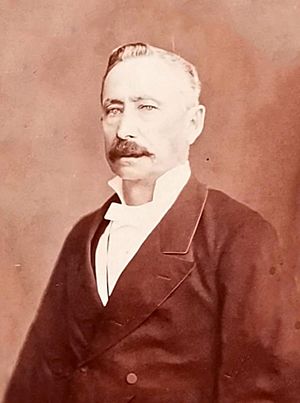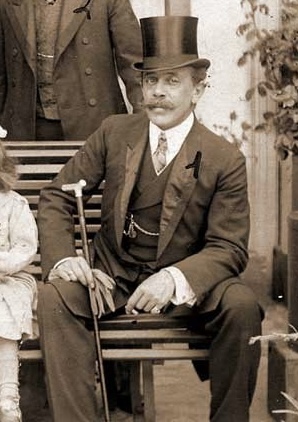Gregorio Pacheco facts for kids
Quick facts for kids
Gregorio Pacheco
|
|
|---|---|
 |
|
| 21st President of Bolivia | |
| In office 4 September 1884 – 15 August 1888 |
|
| Vice President | Mariano Baptista Jorge Oblitas |
| Preceded by | Narciso Campero |
| Succeeded by | Aniceto Arce |
| Personal details | |
| Born |
Gregorio Pacheco Leyes
4 July 1823 Livi Livi, United Provinces of the Río de la Plata (now Bolivia) |
| Died | 20 August 1899 (aged 76) Potosí, Bolivia |
| Political party | Democratic Party Conservative Party |
| Spouse | Corina Aparicio |
| Parents | Brígido Jose Pacheco Josefa Leyes |
| Relatives | Narciso Campero (cousin) |
| Education | University of Saint Francis Xavier |
| Signature | |
Gregorio Pacheco Leyes (born 4 July 1823 – died 20 August 1899) was a successful Bolivian businessman. He later became the 21st president of Bolivia, serving from 1884 to 1888. Pacheco made a huge fortune in silver mining. He was also known for his kindness and generosity, giving a lot of his money to help others.
Early Life and Business Success
Growing Up in Bolivia
Gregorio Pacheco was born in a place called Livi Livi. His parents were José Brígido Pacheco and Josefa Leyes. He started studying at the University of San Francisco Xavier. However, he left his studies early to focus on mining.
Becoming a Mining Millionaire
Pacheco quickly became very rich from his mining work. This wealth allowed him to travel to Europe. There, he learned a lot and gained valuable experience. He was also a cousin of Narciso Campero, who was another important figure in Bolivia.
Becoming President of Bolivia
Winning a Close Election
From a young age, Pacheco became interested in politics. He became the main leader of Bolivia's Democratic Party. In 1884, he won a very close election. He beat Aniceto Arce from the Conservative Party and Eliodoro Camacho from the Liberal Party. Because Pacheco was the richest man in Bolivia, some people questioned if the election was fair.
Leading Bolivia to Peace
Pacheco became president when Bolivia was still recovering from the War of the Pacific. In this war, Bolivia lost its coastal lands. In 1884, Pacheco helped negotiate a truce with Chile. The final peace treaty was signed much later, in 1904. He also worked on a border agreement with Peru in 1886.
Key Achievements as President
Helping His Country Grow
President Pacheco was a very generous leader. He used his own money to build the Sucre Psychiatric Institute. He also created many other social programs to help people in need. To connect distant parts of Bolivia, he founded Puerto Pacheco in 1885. This town was located on the Paraguay River.
Modernizing Bolivia
During his time as president, Bolivia saw many important changes:
- The first international telegraph service was set up. It connected La Paz in Bolivia to Lima in Peru.
- A new bank, the Banco Hipotecario, opened in Sucre.
- Pacheco, along with Aniceto Arce, brought electricity to Bolivia. This was a big step for the country's progress.
- He started building the first steel and cement factories in Bolivia.
- Silver mines expanded, leading to real economic growth in the 19th century.
Important Political Allies
A young politician named Atanasio de Urioste Velasco was a strong supporter of Pacheco. Urioste, even though he was a Liberal, always defended Pacheco's new ideas. Pacheco helped Urioste's career, hoping for his future support. Urioste was also connected to Francisco Argandoña, one of the wealthiest men in Bolivia.
Later Life and Generosity
A Philanthropist's Legacy
Pacheco was known for his amazing generosity. He used his vast wealth from silver mining for many charitable works. He even paid off a debt Bolivia owed to Peru with his own money. This debt was a large sum of 50,000 Bolivian pesos.
He also had strong support from the military. Unlike some past presidents, he worked with the army instead of trying to weaken it. After his term, he supported Aniceto Arce's election campaign in 1888. This was part of an agreement he had made with the Conservative Party.
His Final Years
Gregorio Pacheco passed away in Guadalupe, a mining town in Potosí, on 20 August 1899. A large part of his fortune was given to charities in Bolivia. His two eldest sons inherited the rest of his wealth.
Family Life
Pacheco was married to Corina Aparicio. They had two sons, Gregorio and Daniel. When he became president, he sent his family to Europe. He worried about their safety. Later, his sons moved the family's mining company headquarters to London.
Images for kids
See also
 In Spanish: Gregorio Pacheco para niños
In Spanish: Gregorio Pacheco para niños


